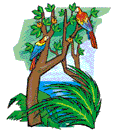Water Ecosystems
A lesson and worksheet on water ecosystems.
Objectives:
• Students will be able to distinguish between salt water and fresh water.
• Students will be able to describe the characteristics of saltwater ecosystems.
• Students will be able to name and describe the two sections of the ocean.
• Students will be able to name and describe the two regions of the ocean.
• Students will be able to name animals that live on the surface and in each region of the ocean.
Suggested Grades:
4th Grade - 5th Grade - 6th Grade
Print the reading comprehension worksheet passage and questions (see below).
Students should read the passage silently, then answer the questions. Teachers may also use the text as part of a classroom lesson plan.
Lesson Excerpt:
There are two kinds of water ecosystems: freshwater and saltwater. Unlike the ecosystems on land, which have different temperatures and levels of precipitation, the main difference between water ecosystems is the amount of salt in the water.
Freshwater ecosystems include lakes, rivers and ponds. Some marshes, swamps and bogs are also freshwater ecosystems. Plants live in the shallow waters of freshwater ecosystems. In fact, you may have walked into one of these places and gotten your feet caught in the cattails, reeds and other plants that grow there. You may also have noticed frogs, turtles or crayfish in the water.
In the deeper parts of lakes, rivers and ponds are larger fish like trout. This area is also home to plankton, algae and protozoa â€" microscopic organisms that are an important part of life in water ecosystems.
Oceans and seas are saltwater ecosystems. They are divided into sections known as the intertidal zone and the open ocean. In the intertidal zone, the water covers the ocean floor at times and at other times, it does not. This is the area where low tides and high tides are measured.
Continued...

Lesson Printables:
Print this printable worksheet for this lesson:


